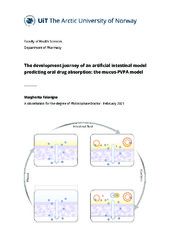| dc.contributor.advisor | Flaten, Gøril Eide | |
| dc.contributor.author | Falavigna, Margherita | |
| dc.date.accessioned | 2021-03-29T12:10:49Z | |
| dc.date.available | 2021-03-29T12:10:49Z | |
| dc.date.issued | 2021-04-23 | |
| dc.description.abstract | Oral drug administration is the most convenient route to systemically deliver drugs because of its cost-effectiveness, ease of administration and high patient compliance. However, when a drug is orally administered it will be exposed to the different physiological processes and environments found along the gastrointestinal (GI) tract, which will determine its ability of being absorbed and reach the systemic blood circulation. For this reason, a close evaluation of the impact of the GI physiology on drug absorption should be carried out when new drugs and formulations are being developed. As a result of this, the need for reliable in vitro models able to mimic both the GI processes and environment has become ever so evident.
To answer the above-mentioned need, this thesis focused on the development of an in vitro model that could be employed to study drug permeation in an intestinally relevant environment. The construction of the model was stepwise. Firstly, the already established in vitro PVPA (Phospholipid Vesicle-based Permeation Assay) barriers were implemented by the addition of a mucus layer to simulate the intestinal mucosa, leading to the mucus-PVPA model. This model demonstrated the ability to distinguish between the permeabilities of drugs with different physicochemical properties. Secondly, intestinally relevant pH conditions were added to the mucus-PVPA model to account for their impact on drug absorption, and commercially available simulated intestinal fluids were also used to increase the biorelevance of the model during permeation studies. The final step was to couple the assessment of drug permeation with in vitro lipolysis to produce a model capable of mimicking both intestinal processes and unraveling the impact of lipid digestion on the permeation of drugs contained in lipid-based formulations. The lipolysis-permeation model demonstrated to predict in vivo drug absorption in rats for three lipid-based formulations, underlining its potential use in the assessment of the performance of novel drugs and formulations. | en_US |
| dc.description.doctoraltype | ph.d. | en_US |
| dc.description.popularabstract | The development of one new drug can take up to 15 years and cost over 22 billion NOK. To overcome these time- and cost-related issues, the need for artificial tools mimicking the human body to study drug absorption has become ever so evident. For orally administered drugs, their capacity to reach the systemic blood circulation depends on their ability to dissolve in the gastrointestinal fluids and cross the intestinal membrane. To estimate how a drug would behave in patients, the thesis focused on the development of the mucus-PVPA model, an artificial tool simulating the membrane and fluids in the intestine. The model was used to study drug permeation, and the obtained results were compared to animal studies. The comparison demonstrated that the artificial model was able to correctly predict drug absorption in animals, likely correlated to the one found in humans. Thus, this novel artificial model showed great potential for further use as a tool in the development of new drugs. | en_US |
| dc.identifier.uri | https://hdl.handle.net/10037/20754 | |
| dc.language.iso | eng | en_US |
| dc.publisher | UiT The Arctic University of Norway | en_US |
| dc.publisher | UiT Norges arktiske universitet | en_US |
| dc.relation.haspart | <p>Paper I: Falavigna, M., Klitgaard, M., Brase, C., Ternullo, S., Škalko-Basnet, N. & Flaten, G.E. (2018). Mucus-PVPA (mucus phospholipid vesicle-based permeation assay): an artificial permeability tool for drug screening and formulation development. <i>International Journal of Pharmaceutics, 537</i>, 213–222. Also available at <a href=https://doi.org/10.1016/j.ijpharm.2017.12.038>https://doi.org/10.1016/j.ijpharm.2017.12.038</a>. Accepted manuscript version available in Munin at <a href=https://hdl.handle.net/10037/14570>https://hdl.handle.net/10037/14570</a>.
<p>Paper II: Falavigna, M., Klitgaard, M., Steene, E. & Flaten, G.E. (2019). Mimicking regional and fasted/fed state conditions in the intestine with the mucus-PVPA <i>in vitro</i> model: The impact of pH and simulated intestinal fluids on drug permeability. <i>European Journal of Pharmaceutical Sciences, 132</i>, 44-54. Also available at <a href=https://doi.org/10.1016/j.ejps.2019.02.035> https://doi.org/10.1016/j.ejps.2019.02.035</a>. Accepted manuscript version available in Munin at <a href=https://hdl.handle.net/10037/14923>https://hdl.handle.net/10037/14923</a>.
<p>Paper III: Falavigna, M., Klitgaard, M., Berthelsen, R., Müllertz, A. & Flaten, G.E. (2021). Predicting oral absorption of fenofibrate in lipid-based drug delivery systems by combining <i>in vitro</i> lipolysis with the mucus-PVPA permeability model. <i>Journal of Pharmaceutical Sciences, 110</i>(1), 208-216. Also available at <a href=https://doi.org/10.1016/j.xphs.2020.08.026>https://doi.org/10.1016/j.xphs.2020.08.026</a>. Accepted manuscript version available in Munin at <a href=https://hdl.handle.net/10037/20753>https://hdl.handle.net/10037/20753</a>.
<p>Paper IV: Falavigna, M., Brurok, S., Klitgaard, M. & Flaten, G.E. (2021). Simultaneous assessment of <i>in vitro</i> lipolysis and permeation in the mucus-PVPA model to predict oral absorption of a poorly water soluble drug in SNEDDSs. <i>International Journal of Pharmaceutics, 596</i>, 120258. Also available at <a href=https://doi.org/10.1016/j.ijpharm.2021.120258>https://doi.org/10.1016/j.ijpharm.2021.120258</a>. Accepted manuscript version available in Munin at <a href=https://hdl.handle.net/10037/20591>https://hdl.handle.net/10037/20591</a>. | en_US |
| dc.rights.accessRights | openAccess | en_US |
| dc.rights.holder | Copyright 2021 The Author(s) | |
| dc.rights.uri | https://creativecommons.org/licenses/by-nc-sa/4.0 | en_US |
| dc.rights | Attribution-NonCommercial-ShareAlike 4.0 International (CC BY-NC-SA 4.0) | en_US |
| dc.subject | VDP::Medical disciplines: 700::Health sciences: 800 | en_US |
| dc.subject | VDP::Medisinske Fag: 700::Helsefag: 800 | en_US |
| dc.title | The development journey of an artificial intestinal model predicting oral drug absorption: the mucus-PVPA model | en_US |
| dc.type | Doctoral thesis | en_US |
| dc.type | Doktorgradsavhandling | en_US |


 English
English norsk
norsk
